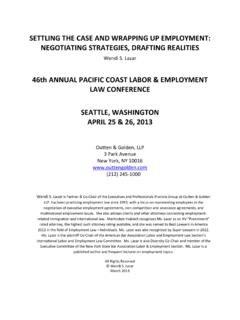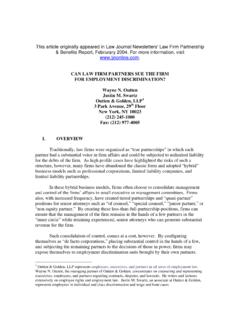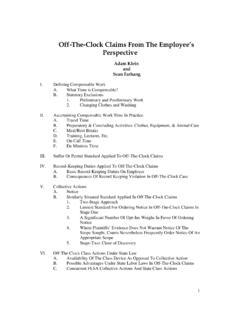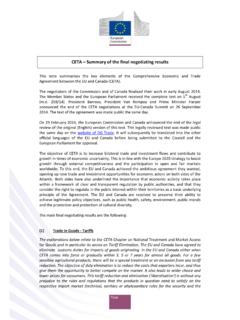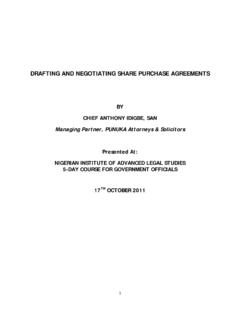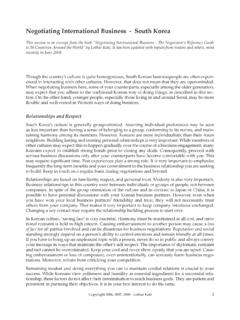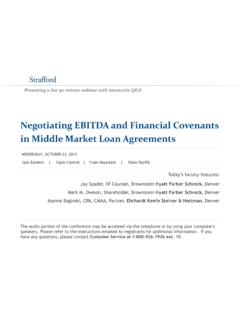Transcription of Negotiating and Drafting Settlement Agreements
1 Excerpt from "Chapter 16. Representing the Executive" by Wayne R. Outten, appearing in Executive Compensation, editors Yale D. Tauber and Donald R. Levy, copyright 2003 The Bureau of National Affairs, Inc. Reprinted by permission. IV. Negotiating AND Drafting Settlement Agreements A. OVERVIEW 1. The Context of the Settlement . This section of the chapter addresses Negotiating and Drafting Settlement Agreements for employment disputes. Settlements may come from direct negotiations between the parties (or their respective counsel), from mediation, or from negotiations before or during arbitration proceedings. In all of these contexts, many substantive issues, and thus many negotiation and Drafting issues will be similar. When the context presents special issues, they will be specifically addressed. 2. Severance Agreements . Upon termination of an employee s employment, most employers provide severance benefits, typically in exchange for a release of claims against the employer.
2 Moreover, many employment disputes arise because the employer terminates or threatens to terminate the employment relationship. Some employment disputes -- involving current employees -- result in a negotiated termination or resignation of employment. All of these situations raise severance issues, so they usually result in an agreement containing provisions typically found in severance Agreements . Accordingly, this section IV, while covering Settlement Agreements , also highlights Negotiating and Drafting issues common in severance Agreements . For further discussion, see Chapter 13. 3. The First Draft of the agreement . It is customary for the employer s counsel to prepare the initial draft of a Settlement agreement involving an employment Thus, the employee s counsel is usually in the position of reviewing and responding to a document prepared by the other side. Typically, that initial draft will be one-sided maybe even outrageously so. Moreover, the employee s counsel has little direct control over the timing of that draft.
3 One way to try to avoid this situation is for the employee s counsel to take the initiative and prepare the draft agreement . Of course, this results in more work for the counsel, at least initially. Some employee s counsel are more than willing to cede the Drafting to the other side, particularly when the counsel is working on a contingency basis. But ceding control over the first draft allows the employer s counsel to determine 1 Almost invariably, a severance agreement will be drafted by the employer s counsel and presented to the employee (or the employee s counsel). when the document is ready,2 what terms are covered, and what language is used to express those terms. Preparing the first draft can be a tactical benefit, especially in Negotiating terms that were not clearly and completely addressed in the pre- Drafting negotiations. And doing so helps insure a balanced and fair first draft. Thus, taking the initiative can improve both the substance and the timing of the final agreement .
4 Typically, once the broad terms of a Settlement have been agreed upon, the employee is eager to get the paperwork done and receive the Settlement proceeds. The employer, on the other hand, has little incentive to expedite the process, unless some external deadline ( , a trial date) is imminent. Indeed, employers sometimes prefer to move slowly if for no other reason than to delay writing the Settlement check. Thus, in the final pre- Drafting stage of negotiations, an employee s counsel should try to get a firm commitment from the other side on the timing of the process, including the date for payment of the Settlement proceeds. To induce the employer to expedite the process, the employee s counsel should try to build financial incentives into the Settlement . The most obvious way to do that is to provide for interest on the Settlement proceeds at a high rate beginning on a specified date, such as ten days after the broad terms of agreement are in place. Another approach is to require the employer to deposit the Settlement proceeds into an interest-bearing escrow account, held by the employee s or the employer s counsel pending the consummation of the deal, with the interest going to the employee.
5 This approach removes the incentive for the employer to move slowly to postpone writing the Settlement check. 4. Reciprocity and Mutuality. After the key financial and non-financial terms of a Settlement have been agreed upon, the employee s counsel should focus on other terms that are sometimes overlooked altogether, or overlooked until the employee s tactical leverage is reduced. These terms include a release in favor of the employee, a favorable oral or written reference, a non-disparagement clause in favor of the employee, and effective enforcement mechanisms for the employer s obligations under the agreement . A useful tactic for the employee s counsel during negotiations on non-financial issues is to insist on reciprocity and mutuality what s good for the goose is good for the gander. Once that principle is established, the employer s counsel will be less likely to insist on extreme provisions in the agreement ( , an onerous liquidated damages clause), and a balanced Settlement agreement is more likely.
6 These issues are addressed in detail later in this section. 2 Employer s counsel will invariably insist on having the employer review and approve the draft before sending it to employee s counsel. Thus, even when the employer s counsel is reasonably prompt in preparing a draft, which is often not the case, the employer s review frequently delays the process longer than the employee and the employee s counsel would like. B. SEVERANCE Agreements SPECIAL ISSUES 1. Generally. As discussed earlier, a severance agreement is a type of Settlement agreement . Typically, severance Agreements are prepared unilaterally by the employer s counsel and presented to the employee to sign. After that, negotiations over the terms may ensue. Negotiations in that context raise some special issues. Should the employee negotiate for a better package or agreement ? Generally, yes. If you don't ask, you don't get.
7 It doesn't hurt to ask. 2. Whether to Negotiate. It depends. Frequently, the employee should try to negotiate an enhanced package, with counsel in the background. This approach is cheaper for the employee and is less confrontational. Often it is far more effective, particularly when the employee s Negotiating leverage is based more on personal and political factors than on legal ones. In those situations, direct intervention by the employee s counsel can be counterproductive, because it appreciably changes the dynamics of the negotiations. Invariably, it precipitates direct involvement by the employer s counsel, who is likely to focus on the legal merits of the employee s position, rather than those personal and political factors that better serve the employee s interests. If the employee is unable or unwilling to negotiate directly, or if that approach appears unpromising, or if it is tried but fails to achieve an acceptable result, then the employee s counsel can step forward to deal directly with the employer, or the employer s counsel.
8 Generally, little is lost by trying this incremental approach. Even when it does not work, the employee and the employee s counsel may learn about the strengths and weaknesses of their bargaining position in the process. 3. With Whom to Negotiate. When the employee is going to negotiate directly with the employer, choosing the person with whom to negotiate is an important tactical decision. Sometimes, the proposed severance agreement or a cover letter specifies who will handle any questions about the agreement . The employee should not feel constrained by that designation since the designated person often is not the best person with whom to negotiate. The employee or the employee s counsel should try to identify someone in the company who has both the power and the inclination to help the employee. Often, the employee is better off Negotiating with people in his or her management chain, with whom the employee has worked, rather than with people in the human resources or counsel s offices.
9 Moreover, the employee generally is better off Negotiating with a human resources representative rather than a company attorney. 4. How to Negotiate. A key to any severance negotiation is determining what Negotiating leverage the employee has and can use. Obviously, that depends on the situation. If the employee has a strong (or at least colorable) legal claim, that is critical leverage, though occasionally it pays to hold it in reserve. Absent a legal claim -- or before asserting one -- the employee can try to "push the buttons" of the employer through people in the company who know and like the employee. The "buttons" include fairness, guilt (a great motivator), fear (of bad publicity, the government, or higher management), and friendship. An especially powerful button is the desire of many company officials to be perceived as fair and reasonable in the eyes of others, such as other employees, senior employees, directors or shareholders of the company, customers or clients of the company, or people in their industry.
10 With some companies and some employees, these non-legal factors work, especially for employees. This is especially true when proposed changes will cost the employer little or no money, while helping the employee. 5. Standard Severance Policies. Typically, it is harder to negotiate potential changes in the context of a reduction-in-force. Employers often say they can't or won't make changes that could undermine the standard package or create a bad precedent. Even in the face of such a mindset, changes can be obtained -- even substantial ones -- through the creative approaches discussed below. 6. Withdrawal of Offer. Can the employer rescind or withdraw a proffered severance package during any consideration period if the employee asks for more? Generally, yes, but it rarely happens. An employee s attorney is safe in assuming that the standard package provided under a company policy or an ongoing exit or reduction program will not be withdrawn. Under the Older Workers Benefit Protection Act, moreover, the employer arguably cannot withdraw the offer during the 21/45 day consideration In any event, the consideration period is routinely extended, though the employee s attorney should be alert to the risk that the employer might not extend it and should get written confirmation of any extension to the extent practicable.
